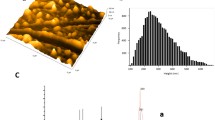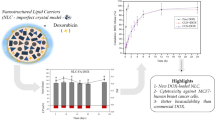Abstract
Purpose
To evaluate the anti-tumor effect of ceramide or trimethylphytosphingosine-iodide (TMP-I) containing solid lipid nanoparticles (SLNs) prepared using trymyristin, phosphatidylcholine (PC), and Pluronic P85 (P85) for intravenous delivery of docetaxel.
Methods
Docetaxel-loaded SLNs using ceramide or TMP-I at 3.22% (w/w) with a mean diameter of 89–137 nm were successfully prepared by high pressure homogenization. The prepared nanoparticles were characterized by particle size, zeta potential, drug content, and TEM analysis. Cellular uptake and cytotoxicity were studied using adriamycin-resistant breast cancer (MCF-7/ADR) cells. The optimized formulation’s dissolution profile, pharmacokinetics, and antitumor effect in mice tumor model were compared with that of control (Taxotere®).
Results
The drug release rate of docetaxel from SLNs was lower than that of control (Taxotere®). The prepared SLNs showed higher cellular uptake of docetaxel compared to that of Taxotere® in MCF-7/ADR cell lines, which was further confirmed by the confocal laser scanning microscopy (CLSM) study using coumarin 6 (C6). Prepared SLNs exhibited significantly increased antitumor efficacy, compared to Taxotere®, in MCF-7/ADR cells. In vivo pharmacokinetic study in rats (at 10 mg/kg dose) showed that the SLNs significantly reduced in vivo clearance of drug than Taxotere®. Interestingly, ceramide and TMP-I SLNs efficiently inhibited the tumor growth compared to Taxotere® in MCF-7/ADR tumor xenografted mouse model.
Conclusion
This work showed that TMP-I and ceramide SLNs not only significantly enhanced systemic exposure of drug, but also increased antitumor efficacy compared to Taxotere® and control SLN.






Similar content being viewed by others
Abbreviations
- AUC:
-
Area Under the Curve
- BA:
-
Bioavailability
- BCRP:
-
Breast cancer resistance protein
- BSA:
-
Bovine serum albumin
- C6:
-
Coumarin 6
- CL:
-
Clearance
- CLSM:
-
Confocal laser scanning microscopy
- DMS:
-
N,N-dimethylphytosphingosine
- DW:
-
Distilled water
- ELS:
-
Electrophoretic light scattering
- HPLC:
-
High performance liquid chromatography
- LLOQ:
-
Lower limit of quantitation
- MDR:
-
Multidrug resistance
- MMS:
-
N-monomethylphytosphingosine
- MRP:
-
Multidrug resistance-associated protein
- MRT:
-
Mean residence time
- P85:
-
Pluronic P85
- PBS:
-
Phosphate-buffered saline
- PC:
-
Phosphatidylcholine
- P-gp:
-
P-glycoprotein
- RBC:
-
Refrigerated bath circulator
- ROS:
-
Reactive oxygen species
- S1P:
-
Sphingosine-1-phosphate
- SD:
-
Sprague Dawley
- SDS:
-
Sodium dodecyl sulfate
- SK1:
-
Sphingosine kinase-1
- SLNs:
-
Solid lipid nanoparticles
- TEM:
-
Transmission electron microscopy
- TMP-I:
-
Trimethylphytosphingosine-iodide
- TMS:
-
N,N,N-trimethylsphingosine
References
Baker J, Ajani J, Scotte F, Winther D, Martin M, Aapro MS, et al. Docetaxel-related side effects and their management. Eur J Oncol Nurs. 2009;13(1):49–59.
Persohn E, Canta A, Schoepfer S, Traebert M, Mueller L, Gilardini A, et al. Morphological and morphometric analysis of paclitaxel and docetaxel-induced peripheral neuropathy in rats. Eur J Cancer. 2005;41(10):1460–6.
Immordino ML, Brusa P, Arpicco S, Stella B, Dosio F, Cattel L. Preparation, characterization, cytotoxicity and pharmacokinetics of liposomes containing docetaxel. J Control Release. 2003;91(3):417–29.
Yin YM, Cui FD, Mu CF, Choi MK, Kim JS, Chung SJ, et al. Docetaxel microemulsion for enhanced oral bioavailability: preparation and in vitro and in vivo evaluation. J Control Release. 2009;140(2):86–94.
Mi Y, Liu Y, Feng SS. Formulation of Docetaxel by folic acid-conjugated d-alpha-tocopheryl polyethylene glycol succinate 2000 (Vitamin E TPGS(2k)) micelles for targeted and synergistic chemotherapy. Biomaterials. 2011;32(16):4058–66.
Cho HJ, Yoon HY, Koo H, Ko SH, Shim JS, Lee JH, et al. Self-assembled nanoparticles based on hyaluronic acid-ceramide (HA-CE) and Pluronic® for tumor-targeted delivery of docetaxel. Biomaterials. 2011;32(29):7181–90.
Nabekura T. Overcoming multidrug resistance in human cancer cells by natural compounds. Toxins. 2010;2(6):1207–24.
Wong HL, Bendayan R, Rauth AM, Li Y, Wu XY. Chemotherapy with anticancer drugs encapsulated in solid lipid nanoparticles. Adv Drug Deliv Rev. 2007;59(6):491–504.
zur Muhlen A, Schwarz C, Mehnert W. Solid lipid nanoparticles (SLN) for controlled drug delivery--drug release and release mechanism. Eur J Pharm Biopharm. 1998;45(2):149–55.
Mehnert W, Mader K. Solid lipid nanoparticles: production, characterization and applications. Adv Drug Deliv Rev. 2012.
Muller RH, Mader K, Gohla S. Solid lipid nanoparticles (SLN) for controlled drug delivery—a review of the state of the art. Eur J Pharm Biopharm. 2000;50(1):161–77.
Woodcock J. Sphingosine and ceramide signalling in apoptosis. IUBMB Life. 2006;58(8):462–6.
Spiegel S, Milstien S. Sphingosine 1-phosphate, a key cell signaling molecule. J Biol Chem. 2002;277(29):25851–4.
Petremand J, Widmann C. Lipid metabolism: sphingolipids- from membrane constituents to signaling molecules that control cell-to-cell communications. Curr Opin Lipidol. 2008;19(6):620–1.
Endo K, Igarashi Y, Nisar M, Zhou QH, Hakomori S. Cell membrane signaling as target in cancer therapy: inhibitory effect of N, N-dimethyl and N, N, N-trimethyl sphingosine derivatives on in vitro and in vivo growth of human tumor cells in nude mice. Cancer Res. 1991;51(6):1613–8.
Park MT, Kang JA, Choi JA, Kang CM, Kim TH, Bae S, et al. Phytosphingosine induces apoptotic cell death via caspase 8 activation and Bax translocation in human cancer cells. Clin Cancer Res. 2003;9(2):878–85.
Kim BM, Choi YJ, Han Y, Yun YS, Hong SH. N, N-dimethyl phytosphingosine induces caspase-8-dependent cytochrome c release and apoptosis through ROS generation in human leukemia cells. Toxicol Appl Pharmacol. 2009;239(1):87–97.
Devalapally H, Duan Z, Seiden MV, Amiji MM. Modulation of drug resistance in ovarian adenocarcinoma by enhancing intracellular ceramide using tamoxifen-loaded biodegradable polymeric nanoparticles. Clin Cancer Res. 2008;14(10):3193–203.
van Vlerken LE, Duan Z, Seiden MV, Amiji MM. Modulation of intracellular ceramide using polymeric nanoparticles to overcome multidrug resistance in cancer. Cancer Res. 2007;67(10):4843–50.
Werle M. Natural and synthetic polymers as inhibitors of drug efflux pumps. Pharm Res. 2008;25(3):500–11.
Mu CF, Balakrishnan P, Cui FD, Yin YM, Lee YB, Choi HG, et al. The effects of mixed MPEG-PLA/Pluronic copolymer micelles on the bioavailability and multidrug resistance of docetaxel. Biomaterials. 2010;31(8):2371–9.
Yan YD, Kim DH, Sung JH, Yong CS, Choi HG. Enhanced oral bioavailability of docetaxel in rats by four consecutive days of pre-treatment with curcumin. Int J Pharm. 2010;399(1–2):116–20.
Lee MK, Lim SJ, Kim CK. Preparation, characterization and in vitro cytotoxicity of paclitaxel-loaded sterically stabilized solid lipid nanoparticles. Biomaterials. 2007;28(12):2137–46.
Song CK, Balakrishnan P, Shim CK, Chung SJ, Kim DD. Enhanced in vitro cellular uptake of P-gp substrate by poloxamer-modified liposomes (PMLs) in MDR cancer cells. J Microencapsul. 2011;28(6):575–81.
Goppert TM, Muller RH. Protein adsorption patterns on poloxamer- and poloxamine-stabilized solid lipid nanoparticles (SLN). Eur J Pharm Biopharm. 2005;60(3):361–72.
Shirahama T, Sweeney EA, Sakakura C, Singhal AK, Nishiyama K, Akiyama S, et al. In vitro and in vivo induction of apoptosis by sphingosine and N, N-dimethylsphingosine in human epidermoid carcinoma KB-3-1 and its multidrug-resistant cells. Clin Cancer Res. 1997;3(2):257–64.
Song CK, Lee JH, Jahn A, Choi MJ, Namgoong SK, Hong SS, et al. In vitro and in vivo evaluation of N, N, N-trimethylphytosphingosine-iodide (TMP) in liposomes for the treatment of angiogenesis and metastasis. Int J Pharm. 2012;434(1–2):191–8.
Yang SC, Lu LF, Cai Y, Zhu JB, Liang BW, Yang CZ. Body distribution in mice of intravenously injected camptothecin solid lipid nanoparticles and targeting effect on brain. J Control Release. 1999;59(3):299–307.
ACKNOWLEDGMENTS AND DISCLOSURE
This research was supported by the National Research Foundation of Korea (NRF), funded by the Korean government (MSIP) (No. NRF-2015R1A1A1A05027671).
Author information
Authors and Affiliations
Corresponding authors
Rights and permissions
About this article
Cite this article
Balakrishnan, P., Song, C.K., Jahn, A. et al. Ceramide and N,N,N-Trimethylphytosphingosine-Iodide (TMP-I)-Based Lipid Nanoparticles for Cancer Therapy. Pharm Res 33, 206–216 (2016). https://doi.org/10.1007/s11095-015-1780-5
Received:
Accepted:
Published:
Issue Date:
DOI: https://doi.org/10.1007/s11095-015-1780-5




